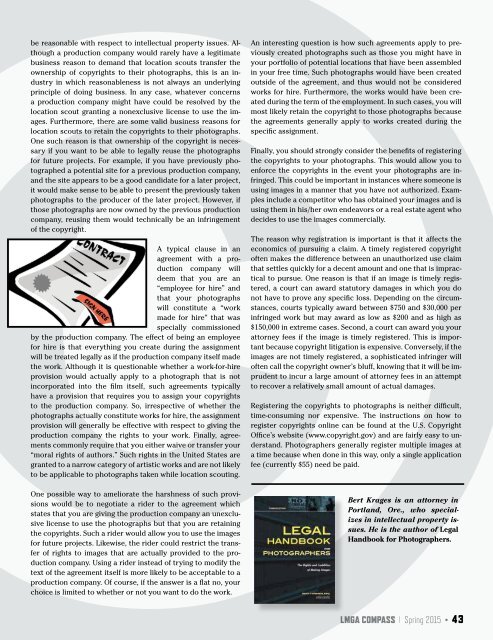LMGA-Compass-Spring-2015-New-1
LMGA-Compass-Spring-2015-New-1
LMGA-Compass-Spring-2015-New-1
You also want an ePaper? Increase the reach of your titles
YUMPU automatically turns print PDFs into web optimized ePapers that Google loves.
e reasonable with respect to intellectual property issues. Althougha production company would rarely have a legitimatebusiness reason to demand that location scouts transfer theownership of copyrights to their photographs, this is an industryin which reasonableness is not always an underlyingprinciple of doing business. In any case, whatever concernsa production company might have could be resolved by thelocation scout granting a nonexclusive license to use the images.Furthermore, there are some valid business reasons forlocation scouts to retain the copyrights to their photographs.One such reason is that ownership of the copyright is necessaryif you want to be able to legally reuse the photographsfor future projects. For example, if you have previously photographeda potential site for a previous production company,and the site appears to be a good candidate for a later project,it would make sense to be able to present the previously takenphotographs to the producer of the later project. However, ifthose photographs are now owned by the previous productioncompany, reusing them would technically be an infringementof the copyright.A typical clause in anagreement with a productioncompany willdeem that you are an“employee for hire” andthat your photographswill constitute a “workmade for hire” that wasspecially commissionedby the production company. The effect of being an employeefor hire is that everything you create during the assignmentwill be treated legally as if the production company itself madethe work. Although it is questionable whether a work-for-hireprovision would actually apply to a photograph that is notincorporated into the film itself, such agreements typicallyhave a provision that requires you to assign your copyrightsto the production company. So, irrespective of whether thephotographs actually constitute works for hire, the assignmentprovision will generally be effective with respect to giving theproduction company the rights to your work. Finally, agreementscommonly require that you either waive or transfer your“moral rights of authors.” Such rights in the United States aregranted to a narrow category of artistic works and are not likelyto be applicable to photographs taken while location scouting.One possible way to ameliorate the harshness of such provisionswould be to negotiate a rider to the agreement whichstates that you are giving the production company an unexclusivelicense to use the photographs but that you are retainingthe copyrights. Such a rider would allow you to use the imagesfor future projects. Likewise, the rider could restrict the transferof rights to images that are actually provided to the productioncompany. Using a rider instead of trying to modify thetext of the agreement itself is more likely to be acceptable to aproduction company. Of course, if the answer is a flat no, yourchoice is limited to whether or not you want to do the work.An interesting question is how such agreements apply to previouslycreated photographs such as those you might have inyour portfolio of potential locations that have been assembledin your free time. Such photographs would have been createdoutside of the agreement, and thus would not be consideredworks for hire. Furthermore, the works would have been createdduring the term of the employment. In such cases, you willmost likely retain the copyright to those photographs becausethe agreements generally apply to works created during thespecific assignment.Finally, you should strongly consider the benefits of registeringthe copyrights to your photographs. This would allow you toenforce the copyrights in the event your photographs are infringed.This could be important in instances where someone isusing images in a manner that you have not authorized. Examplesinclude a competitor who has obtained your images and isusing them in his/her own endeavors or a real estate agent whodecides to use the images commercially.The reason why registration is important is that it affects theeconomics of pursuing a claim. A timely registered copyrightoften makes the difference between an unauthorized use claimthat settles quickly for a decent amount and one that is impracticalto pursue. One reason is that if an image is timely registered,a court can award statutory damages in which you donot have to prove any specific loss. Depending on the circumstances,courts typically award between $750 and $30,000 perinfringed work but may award as low as $200 and as high as$150,000 in extreme cases. Second, a court can award you yourattorney fees if the image is timely registered. This is importantbecause copyright litigation is expensive. Conversely, if theimages are not timely registered, a sophisticated infringer willoften call the copyright owner’s bluff, knowing that it will be imprudentto incur a large amount of attorney fees in an attemptto recover a relatively small amount of actual damages.Registering the copyrights to photographs is neither difficult,time-consuming nor expensive. The instructions on how toregister copyrights online can be found at the U.S. CopyrightOffice’s website (www.copyright.gov) and are fairly easy to understand.Photographers generally register multiple images ata time because when done in this way, only a single applicationfee (currently $55) need be paid.Bert Krages is an attorney inPortland, Ore., who specializesin intellectual property issues.He is the author of LegalHandbook for Photographers.<strong>LMGA</strong> COMPASS | <strong>Spring</strong> <strong>2015</strong> • 43


